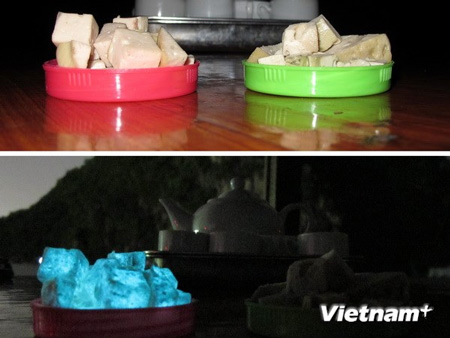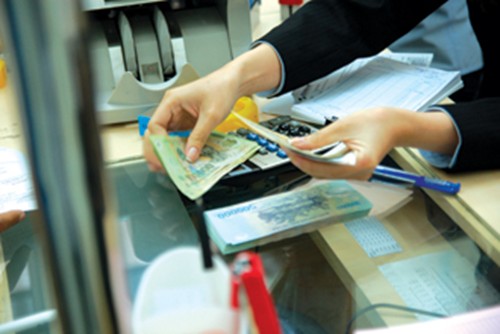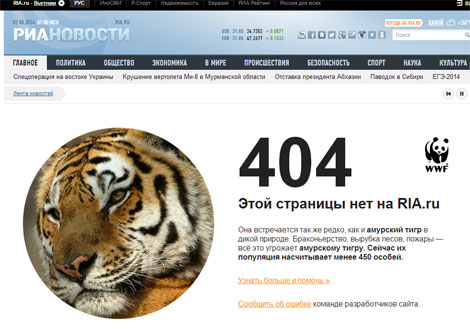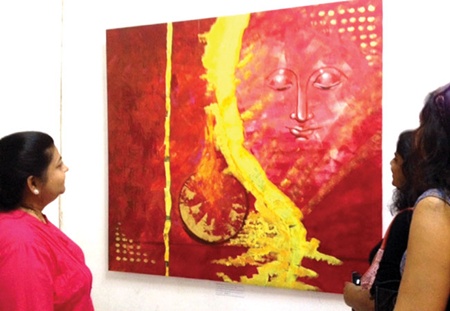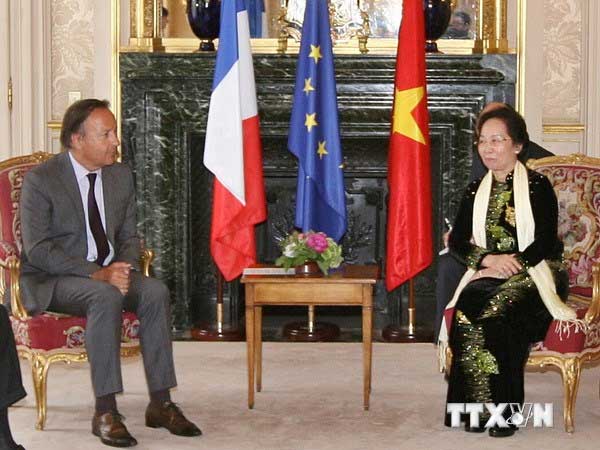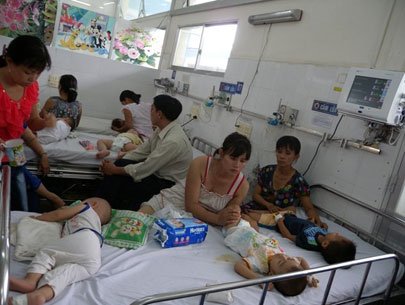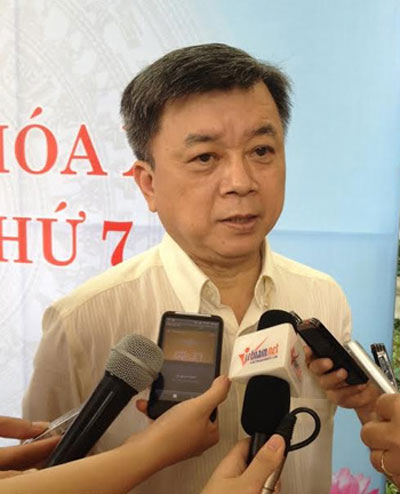BUSINESS IN BRIEF 5/6
Greenback rises to one-year high The U.S. dollar rose to the highest level over the past year versus Vietnam dong on June 3, staying at VND21,220 per dollar. Vietcombank in the afternoon on June 3 quoted the greenback at VND21,220 per dollar, up VND40 against the previous day. The currency increased by VND115 a dollar, or 0.5%, compared to a month ago. According to the website of the central bank, the dong-U.S. dollar exchange rate on the inter-bank market was VND21,036 per dollar on June 3, still lower than the ceiling of VND21,246. Meanwhile, the dollar was traded for VND21,370 on the unofficial market, which was unchanged from the previous day, according to the owner of a gold shop in HCMC. At a meeting with representatives of banks in HCMC on May 22 after the dollar fluctuated on both official and black markets, Nguyen Phuoc Thanh, deputy governor of the central bank, said some banks might have raised dollar prices given concerns over further price increases. However, the central bank will not intervene in the market if dollar prices are still moving within the allowable trading band of 1%. Thanh said that there was no pressure on the forex rate as the nation’s exports in the first four months this year increased 19% against the same period of last year. In addition, incoming remittances and foreign reserves remain strong. Meanwhile, Saigon Jewelry Company (SJC) quoted gold at VND36.28 million per tael on June 3, falling by VND40,000 against the previous day. This was the lowest over the past 10 days. A tael equals to 1.2 troy ounces. Few Vietnamese businesses open to outsourcing study Most Vietnamese companies are unwilling to use outsourcing despite its benefits like the reduction in management work and payroll without any impact on output, according to a report by business consultancy Grant Thornton. The International Business Report, based on interviews conducted last November with more than 3,300 CEOs, managing directors, chairpersons, and other senior executives from all industry, reveals that only 12% of businesses in Vietnam are open to outsourcing. The effectiveness and cost saving of outsourcing are not realised by many Vietnamese companies, and so the service providers need to increase access to these companies, a potential market, said Trinh Thi Tuyet Anh, director of outsourcing at Grant Thornton Vietnam. In certain cases, enterprises think they could lose control over critical business processes if they outsource, she said. For small- and medium-sized enterprises in Vietnam, the cost of professional outsourcing services will be a considerable expense, she added as a reason for the unwillingness of Vietnamese firms. Globally too the majority of business leaders have no plans to outsource any business processes in the near future. While the cost savings and process efficiencies that outsourcing can provide are widely recognised, many business leaders are worried about losing control of key processes. Around 60% of global businesses have no immediate plans to outsource a business process. Outsourcing is least prevalent in Southeast Asia (26%), Eastern Europe (31%), and the Nordic countries (33%). By contrast, more than half of businesses in southern Europe (64%) and Latin America (51%) either currently outsource or plan to. Trinh Thi Tuyet Anh, director of outsourcing at Grant Thornton Vietnam, said outsourcing is a helpful tool for restructuring manpower; freeing resources from administration, and re-allocating them to operations. Among those businesses which currently (or plan to) outsource back-office services, 57% globally cited improving efficiencies — marginally ahead of reducing cost (55%) — as the key drivers. In Asia - Pacific, both figures are 37%. Of those businesses with no plans to outsource, the requirements to find cost savings (41%) and process efficiencies (33%) are the main reasons that will encourage them to consider it. Anh said the results clearly show that outsourcing is worthy of serious consideration. Aside from driving efficiencies and reducing costs, outsourcing can allow business to tap into skills and expertise offered by their providers that might not necessarily be as readily available in the local labour market. More domestic consumers put purchases on credit Consumer habits of Vietnamese are changing, with an increasing number looking to purchase their desired products through affordable loans. Igor Prerovsky, General Director of Home Credit Vietnam, invested by PPF, said at June 3 conference on consumer finance that consumer credit, which helps consumers buy their desired items and pay later, is expanding in Vietnam. Statistics released by Home Credit showed that around 20% of consumers in the country's southern part make purchases on credit while it accounts for around 10% in the north. These figures are showing signs of increasing. Prerovsky pointed out that consumer finance is another way to contribute to economic development through boosting purchasing capacity and demand, while enhancing living standards of consumers. This also helps consumers to form a habit of saving, he added. In addition, financial companies targeted low-income earners rather than the middle-class, in comparison with retail banks. Home Credit, with more than 5,000 points of sale in all 63 provinces and cities in Vietnam, said fast, simple and professional services are the core basis for competition in the consumer lending sector but credit safety must be ensured. Vietnamese, Bulgarian firms look to the future Vietnamese enterprises and their Bulgarian counterparts have inked a number of partnership deals at a recent business forum in Sofia, the capital of Bulgaria, after a record turnout of 180 attendees found many areas for cooperation. The deals cover a broad spectrum of areas, ranging from tobacco, paper export-import, garment accessories to confectionery. Deputy Minister of Industry and Trade Ho Thi Kim Thoa, gave assurances that the ministry will help bolster ties between the two business communities in every possible way. In his speech, Vietnamese Ambassador Le Duc Luu highly recommended the new economic partnership model reached by both countries’ leaders. Once active, it will become an exemplary model for Vietnamese and Bulgarian stakeholders, he said. Many Vietnamese firms in Bulgaria have already poured their money into their homeland and shipped Vietnamese goods to other European markets. Two-way trade between Vietnam and Bulgaria averages US$70-80 million annually. The event was co-hosted by the Vietnamese Ministry of Industry and Trade and the Bulgarian Ministry of Economy and Energy. Korean Dong-IL Group builds first textile factory in Vietnam June 3 marked the start of construction by the Republic of Korea’s (RoK) Dong-IL group on its first textile factory in Vietnam at Loc An-Binh Son Industrial Zone in Long Thanh district, Dong Nai province. The facility, to be built on 12ha at a cost of nearly US$52 million, will have an annual capacity of 9,000 tonnes of products. Dong –IL leaders said when the Posco E & C Vietnam factory is put into operation in 2015 as scheduled, it will generate hundreds of jobs for local people and its products will be exported to Asian markets. Phan Thi My Thanh, Vice Chairwoman of the Dong Nai provincial People’s Committee, said 31 out of 35 industrial zones have been built on nearly 10,000ha in the province. They attracted more than 1,100 foreign direct investment (FDI) projects with a combined capitalisation of nearly US$20.6 billion. The RoK ranks second among foreign investors in the province with 276 projects capitalized at more than US$4 billion. Thanh expressed her hope that Dong-IL group and other Korean businesses in the province will help lure more Korean investors to the locality. 20% of Australian seafood imported from Vietnam Vietnam is the third largest supplier of seafood to Australia, after New Zealand and China. According to the Vietnamese Trade Office in Australia, the country imports more than 200,000 tonnes of seafood worth US$1 billion annually. Its demand is set to increase in the future, creating huge opportunity for Vietnamese seafood products. Large volumes of shrimp are consumed in Australia, with over 50,000 tonnes every year. More and more Australians are choosing frozen shrimp imported from Thailand and Vietnam due to cheap prices and improved quality. Last year, Vietnam’s shrimp exports to the country rose by 27.5% fetching over US$128 million. Australia is the sixth largest consumer of Vietnamese shrimp, after the US, Japan, the EU, China and the Republic of Korea. As Australia imposes strict regulations on food hygiene and safety, Vietnamese businesses are advised to ship high quality products with clear origin if they want to break into this demanding market. In addition, Vietnamese suppliers are encouraged to make fact-finding tours of Australia to better understand local consumers’ taste and devise proper solutions for the retail and wholesale systems there. ASEAN Customs chiefs meet in Lam Dong The 23rd Meeting of the ASEAN Directors-General of Customs opened in Da Lat City, Lam Dong province, on June 3, bringing together nearly 70 delegates from ASEAN, Japan, the Republic of Korea and China. Participants discussed and proposed orientations, action plans and working programmes for ASEAN customs in the 2016-2020 period. In recent times, ASEAN customs has achieved significant progress in building the ASEAN Economic Community (AEC) in 2015. They have signed an agreement on customs, created a legal framework for implementing the ASEAN customs transit system (ACTS), and initially established the single-door customs mechanism in all ASEAN countries. 2014-2015 is considered a pivotal time for ASEAN to enter a new period of cooperation, integration and connectivity towards AEC. ASEAN Secretary General Le Luong Minh said the results of the meeting will be an important step towards forming an ASEAN Community in 2015 as scheduled and beyond. Customs cooperation must bring out more specific results in the future, he stressed. This is the third time Vietnam has hosted such event after meetings in 1995 and 2004. Vietnam Customs Director General Nguyen Ngoc Tuc took the occasion condemning China’s provocative actions in the EastSea, following its illegal placement of the oil rig Haiyang Shiyou-981 deep within Vietnam’s exclusive economic zone. He called on participating delegates to voice opposition to China’s act and support Vietnam’s peaceful struggle for justice. Secretary General of World Customs Organisations (WCO) Kunio Mikuriya said the current EastSea tension partly affects maritime transport in the region. He expressed his belief that parties concerned will settle the dispute peacefully to ensure maritime safety and promote goods circulation and trade liberalisation in the EastSea and Asia-Pacific as well. Dubai group looks to invest in Vietnam Representatives from the largest Dubai group, ICD, are due to make a fact-finding tour of Vietnam to seek investment opportunity, especially in real estate in Quang Ninh province. The commitment was made at a working session between ICD executives and Quang Ninh leaders following the latter’ recent visit to the United Arab Emirates (UAE). Quang Ninh leaders briefed their hosts on the provincial socio-economic development master plan, including turning its Van Don economic zone into a special economic zone in the future with preferential policies. It may coincide with Dubai ICD development of the “Future city” project. Jawad Khan, Dubai ICD representative, affirmed that the group will send a delegation to Quang Ninh late this year to seek investment opportunity there. Dubai ICD is the UAE investment fund. It currently manages a huge property portfolio worth US$120 billion, including Emirates Airlines, Emaar, Emirates National Bank and many other companies. East Sea dispute encourages consumption of Vietnamese goods, deputy minister The ongoing EastSea dispute between Vietnam and China is an impetus for Vietnamese to prioritize consumption of domestically made products, said Mr. Do Thang Hai, Deputy Minister of Industry and Trade during a press conference on June 2. Hai said that in order to narrow the trade deficit with China, Vietnam needs to increase exports and reduce imports. The growth rate of Vietnamese goods touched 28.4 percent in the first four months this year, showing that several domestic products have been able to compete with Chinese goods, Hai added. “In addition, the campaign ‘Vietnamese prioritize consumption of Vietnamese goods’ is launching to be drastically implemented to take advantage of the 90 million people market”, he said. Vietnam is consuming several products that are to meet with requirements from the US and EU markets. China’s oil rig placing on Vietnam’s continental shelf in May has prompted Vietnamese businesses and authorized agencies’ determination to implement the campaign. Consumption of Vietnamese goods is patriotic at this time, Hai concluded. Customs work overtime to help foreign firms The Vietnam Customs has instructed its agencies to work overtime in weekday, at the weekend and in holidays to clear customs procedures for foreign companies hit by anti-China protests. The instruction said that customs departments in provinces and cities should arrange a division to directly receive and solve problems for businesses and provide them with specific contacts. They should also send officials to work with the companies and authorized agencies to assess losses of businesses. This aims to calculate the exempt or reduced tariff on damaged commodities and to extend tax payment deadlines for them. Customs officials must facilitate customs clearance for export and import consignments of businesses including those that owe taxes so that they can resume production and meet their orders. Binh Dinh makes ODA call out for project wish-list Located in the southern-central coastal region, Binh Dinh is a key gateway to the country’s highland provinces, southern Laos and northeast Cambodia and Thailand. The province has rich maritime and other natural resources, and huge potential for tourism. However, like many other provinces in Vietnam, Binh Dinh is facing many challenges in its economic development. Those challenges include underdeveloped infrastructure and an economy that remains dependent on agriculture. Because the province is located in the central coastal region, it regularly suffers from natural disasters such as typhoons. Binh Dinh has learnt the importance of utilising all available resources to develop. As investment from the private sector in transportation infrastructure, healthcare, and education lags behind demand, official development assistance (ODA) from international donors is vital to the province. In recent times, international donors have provided $281.44 million in ODA to 21 projects in Binh Dinh. To call for more financial support from international donors, the province has completed a list of projects needing ODA from 2015-2020. The list comprises 32 projects with a combined investment capital of $361.82 million, with $334.38 million needing to be raised from international donors and the remainder coming from the provincial budget. All of the projects are in the fields of healthcare, education, transport infrastructure, environment, agriculture, irrigation, and water supply. Specifically, there are two projects in the healthcare and education sectors, capitalised at $38.5 million, three infrastructure projects with $92.25 million in total, and six projects in the environment field with total capital of $41.15 million. The agriculture and irrigation sectors include 14 projects with $79.82 million in total investment and five projects in water supply with $73.65 million. Binh Dinh is doing its utmost to develop the local economy, but needs the support of the central government and international donors to make these efforts become a reality. Viettel’s switchboard for ethnic customers wins global prize The Military Telecom Corporation (Viettel) has won a silver Stevie Awards in the category of New Consumer Service of the Year for its ethnic minority language mobile phone services, which made debut in January 2013. The awards ceremony to honour the winners was held in Seoul, the Republic of Korea, on May 30. The switchboard, the first of its kind in Vietnam, provides ethnic minority users with a wide range of entertainment services such as storytelling, music programmes, and farming guidance in their mother tongues. With over 120 telephone operators and an automatically answer calls switchboard providing inquiry services in 10 ethnic minority languages, the telecom firm has served as many as 2.5 million customers over the past year, or an average 30,000 calls each day, according to the group. Vietnam is home to about 12 million people of ethnic minority groups, accounting for 15 percent of the nation’s population. However, only 25 percent of them or three million people are using mobile services. Viettel has so far operated customer care switchboards in the northwestern region, the Central Highlands, northern Thai Nguyen province, and the Mekong Delta localities of Can Tho and An Giang. Initiated in 2002, Stevie Awards is one of the world’s leading prizes to honour active contributions by individuals and businesses to the development of community-based interests, including the fields of telecom and information technology. Vietnam-Singapore business forum to bolster trade More than 100 representatives from governmental agencies, enterprises and organisations will attend the 2014 Vietnam-Singapore Business Forum (VSBF 2014), which is expected to promote economic cooperation between the two countries. Hosted by the Vietnam Chamber of Commerce and Industry (VCCI) in Ho Chi Minh City from June 4-6, the event will provide a business platform for enterprises from both countries to explore cooperation opportunities, particularly in the context of a strategic partner agreement adopted by the two countries in September last year. It will also be a good chance for attendees to be updated on trade and investment policies of the two governments, thus helping them make appropriate business strategies in the future. During the event, participants will focus their discussion on how to foster partnership between the two sides in the fields of financial services, agriculture and aquaculture production, tourism and hospitality, real estate and environment management for sustainable business development. Two-way trade between Vietnam and Singapore in the first two months of this year enjoyed a year-on-year increase of 20 percent, reaching 2.2 billion USD. Singapore is currently the third largest foreign investor in Vietnam with 1,258 valid projects worth more than 30 billion USD.- Mongolia, Vietnam friendship associations hold business seminar The Mongolia-Vietnam Friendship Association and the Vietnam-Mongolia Friendship Association have jointly organised a seminar for the two countries’ businesses in Mongolia. Both sides agreed that the seminar offered a good chance for businesses to exchange experience and expand connections. They vowed to continue helping the two countries’ enterprises strengthen their cooperation in order to boost bilateral economic and trade ties and enhance mutual trust and understanding between the two peoples. During the seminar, the two associations also issued a joint statement voicing deep concerns over the current EastSea situation after China illegally placed its Haiyang Shiyou-981 drilling rig in Vietnam’s exclusive economic zone and continental shelf in early May. Besides, Chinese ships deployed to defend the rig have repeatedly rammed and fired water cannons into Vietnamese coast guard and fisheries surveillance ships which are carrying out their law enforcement missions in the country’s waters, leaving many Vietnamese ships damaged and officers injured. Participants agreed that China’s unilateral acts gravely infringe Vietnam’s sovereignty, sovereign right ad jurisdiction stipulated in the 1982 United Nations Convention on the Law of the Sea, violating the 2002 Declaration on the Conduct of Parties in the EastSea. These acts are also worrying neighbouring countries of China, they added. During its stay in Mongolia from June 1-6, the Vietnam-Mongolia Friendship Association delegation led by its President Ho Xuan Hung has visited the Mongolian Union for Peace and Friendship and the Ho Chi Minh high school in Ulaanbaatar capital city.- Vinacomin sets high June target The Vietnam National Coal and Mineral Industries Group (Vinacomin) expects to sell around 10 million tonnes of its products in the April-June period and export at least 1.5 million tonnes. To realise the goal, the corporation has taken a number of measures to promote the production of high-quality coal, satisfying customer demand and ensuring good income for workers. In the first five months of 2014, it sold 16 million tonnes, down nearly 11 percent year-on-year, and shipped over 3.7 million tonnes abroad, only 62.6 percent of the same period last year. Despite an array of economic difficulties in 2013, the group earned more than 97 trillion VND (over 4.6 billion USD) from selling 39 million tonnes of products, including 11.6 million tonnes for export. HCMCity, Japanese region further industrial cooperation The Ho Chi Minh City People’s Committee and the Economy, Trade and Industry Department of Japan’s Kansai region on June 2 signed a framework agreement on cooperation, under which they will enhance connections in support industry. The two sides will also speed up the establishment of a business environment that can facilitate Kansai enterprises’ investment in the support industry in Ho Chi Minh City . The city has assigned its management board of industrial and export processing zones to set up a division in charge of connecting ties with Kansai and providing consultations for its enterprises. At a meeting with the Japanese guests earlier, Chairman of the municipal People’s Committee Le Hoang Quan said that Vietnam in general and Ho Chi Minh City in particular, commits to creating all favourable conditions for foreign investors, considering them part of the country’s economy. Toshinori Kobayashi, head of the Kansai department, the region’s businesses, especially those operating in the support industry, are paying much attention to boosting investment in Ho Chi Minh City and its surrounding areas. New Binh Dinh fishing port to open in 2016 The World Bank has financed a 47 billion VND (2.2 million USD) project to upgrade De Gi fishing port in the central coastal province of Binh Dinh, a local official has said. Tran Van Vinh, Deputy Director of the management board of the provincial Coastal Resources for Sustainable Development (CRSD) project, noted the upgrade will allow the port to handle around 3,000 boat arrivals a year, mainly following fishing voyages, and improve the quality of seafood processing. Once finished in 2016, the expanded port, covering 2.4 ha in Phu Cat district, is expected to generate jobs for up to 600 local labourers. It will have a clean water system designed to treat wastewater, along with other facilities. Vice Chairman of the Phu Cat People’s Committee Luong Ngoc Anh emphasised the importance of the port as it will be able to serve as a safe shelter for boats in stormy weather, while bringing in many economic benefits. Dong Nai continues export growth trend The southern province of Dong Nai pocketed over 1 billion USD from exports in May, with a massive 931 million USD made by foreign-invested firms, a trade official has reported. The state and domestic private sectors contributed 98 million USD and 13 million USD respectively, according to Deputy Director of the provincial Department of Industry and Trade Nguyen Van Quan. In the first five months of 2014, Dong Nai recorded around 4.98 billion USD in export earnings, a yearly surge of 16.1 percent, driven by high-value garments, wooden products, iron, steel, machinery and coffee. The high performance is in part due to a series of trade promotion events that the sector has hosted in and outside the country since the start of this year. In the face of volatile business climate around the world, with the ongoing dispute in the EastSea and slow resilience of US and Japanese economies, Quan promised all possible support for domestic exporters, making it easier for them to access preferential loans. Throughout the rest of this year, trade fairs and exhibitions in key economic zones in Binh Duong, Da Nang, Germany, Myanmar and the Republic of Korea will involve more local stakeholders, he vowed. Bac Lieu aquatic exports see record high Aquatic exports of the Mekong Delta province of Bac Lieu in the first five months of 2014 leapt by 68 percent from the year before to reach 170 million USD, the highest ever for the period. Prices of aquatic exports have increased by 2-3 USD/kg on average, benefiting both farmers and businesses. In recent years, local exporters have reportedly paid due attention to protecting their trademarks and ensuring the quality of products, while authorities have also facilitated their access to preferential credit sources to renovate production lines. In the coming time, managerial agencies plan to help the Bac Lieu business circle expand its partnership with foreign enterprises to drive trade. Businesses will also receive more assistance to build their own aquatic farms in order to ensure a stable and quality input. Currently, Bac Lieu has more than 100,000 hectares of shrimp farm and 495 fishing vessels. Great opportunity for Vietnam to develop supporting industry Vietnam is facing a great opportunity to develop its supporting industry. However, proposals are needed regarding the best ways to take advantage of opportunities. Certainly, efforts of the government as well as Vietnamese businesses are vital, the Communist Party of Vietnam (CPV) Online Newspaper said. This is the theme of the 10th supporting industry forum, titled “How to develop the supporting industry in Vietnam” held on May 22 by the Japan External Trade Organisation (JETRO), the Investment & Trade Promotion Centre of Ho Chi Minh City (ITPC) and Reed Tradex company. Hirotaka Yasuzumi, Managing Director of the JETRO office in Ho Chi Minh City, said in 2013, total direct investment capital of Japanese enterprises licensed in Vietnam was 22.4 billion USD, with 500 projects, accounting for 26 percent of total FDI. The figures show that Japan is still the largest investor. Japanese companies continue to be highly active in Vietnam. A difficulty for Japanese companies is the shortage of supporting industries in the domestic market. A 2013 JETRO Survey showed that the proportion of domestic supply for the Japanese companies was less than 32 percent in Vietnam compared to 64 percent in China and 53 percent in Thailand. Over the past ten years, JETRO has attempted to improve the sector through trade exchanges and exhibitions for supporting industry but it has not improved significantly. Bui Quang Hai, representative of the Ho Chi Minh City Association of Mechanical Engineering (HAME), shared that Vietnam’s manufacturing enterprises only meet 11 percent of the needs of Japanese companies in Vietnam. In recent years, Vietnam’s export of electronic products, computers and phones has achieved high revenue and increased to double digits, but these are products from FDI enterprises. Imports account for 58 percent of Vietnam’s total export value. This equates to about 40 billion USD of manufactured technology products. Phone components alone stand at almost 20 billion USD. These imports come mainly from China. Many enterprises admit that their operations depend on materials sourced from abroad. “Currently, we are facing opportunities with Japan to build an industrial cooperation strategy between Vietnam and Japan through 2020 with a vision to 2030. In this regard, six industries stand out, including electronics, agricultural and agricultural product processing machines, environment, energy saving, shipbuilding and automotive parts manufacture,” said Hai. More specifically, Hirotaka Yasuzumi said that this year JETRO plans to cooperate between private enterprises and the relevant state agencies for the development of supporting industries. The organisation has promoted technological transfer to Vietnamese enterprises by encouraging development of human resources and establishing close ties with Japanese companies. Duangdej Yuaikwarmdee, Deputy Executive Director of Reed Tradex Company, which has co-hosted the supporting industry forum over the past ten years, commented that Vietnam is now an attractive investment destination for international manufacturers in the fields of automotive, electronics and supporting industries. Japanese companies are continuing to expand their production capacity in the domestic market in the near future. Finding suitable partners for business cooperation will also help to strengthen Vietnam’s industry and achieve long term profitability. Garment enterprises tend to be largely dependent on importing raw materials from China, which does not participate in the Trans-Pacific Partnership Agreement (TPP). These companies are searching for new import markets in order to qualify for tax advantages when exporting to the US. Chairman of the Association of Garment-Textile-Embroidery-Knitting in HCMCity (Agtex) Pham Xuan Hong said Agtex and its members are seeking raw material sources within the country as well as countries participating in the TPP. In the coming time, Agtex will send representatives to Malaysia to discuss cooperation with Malaysia’s Association of Textile and Garment with a view to exploiting the advantages of the businesses of the two countries. “Since enterprises investing in Vietnam’s materials sector are few we need to adopt policies to attract more investment in this sector. There is a significant need for preferential policies in capital and land-rent price for domestic enterprises to invest in textiles and dye because the investment in these fields needs a big capital injection of thousands of billions of VND. Without preferential terms, there will not be sufficient private enterprise willing to borrow money for the relevant investment,” said Pham Xuan Hong. According to the Chairman of the Board of Directors of Saigon Garment Manufacturing Trading Joint Stock Company (Garmex) Le Quang Hung, the domestic textile sector has not kept up with the growth of the garment sector in recent times. Domestic garment enterprises like Garmex have been searching for locally sourced raw materials to reduce costs, but many kinds of fabrics are not produced in-country. Meanwhile, most businesses in the sector are not sufficiently resourced in terms of capital and technology to produce raw materials for the garment sector, especially the textile and dye sectors. Moreover, many localities don’t want to grant license to build dye factories due to environmental impact. “When negotiating TPP, we must sacrifice benefits of some sectors to receive the export tax exemption for the garment and textile sector. If we do not take advantage of the opportunity, it is insignificant to perform TPP, especially with regard to regulations on the origin of raw materials. Consequently, it is necessary to have policies to develop the sector providing the garment and textile materials clearly published from the Government,” Hung said. VN's import, export policies remain unchanged Most businesses which suffered damages in southern industrial zones have so far resumed their productions, according to the Vietnam Economic News on June 2. The Ministry of Industry and Trade (MOIT) has provided timely guidance to stabilise investment and import, export activities, making foreign businesses feel secure about their operations in Vietnam. The Formosa Group’s steel projects are in the process of overcoming the damage and gradually resuming operations while bauxite projects in Dak Nong and Lam Dong provinces are operating normally, the online newspaper said. The Viet Trung Minerals and Metallurgy Company Limited produced its first batch of 50 tonnes of cast iron on May 26, 2014. The company said that experts were examining the quality of cast iron so that it could be refined to produce the first batch of steel billets. Chinese and Vietnamese experts and workers are working together in this project. Foreign invested projects in the field of energy, including projects with the participation of Chinese contractors, are going on normally. China is Vietnam’s one of the largest import and export markets. Therefore, many people expressed their concerns that developments in the EastSea would create pressures on the Vietnamese economy. So far, however, according to the Agency of Foreign Trade under the MOIT, the volume of imports, exports in the southern region has remained equal to that in the time prior to China’s illegal installation of its Haiyang Shiyou-981 oil rig in Vietnam's exclusive economic zone and continental shelf in the East Sea. In the central region and CatLaiPort area, there has been a slight slowdown in import, export activities because businesses are overcoming damages to resume production. The Agency of Foreign Trade has provided guidance for the export-import management divisions of Dong Nai and Binh Duong province to provide assistance for businesses which suffered damage. In Ho Chi Minh City, there has been false information that Vietnam does not allow domestic businesses to trade with Chinese partners, so some businesses did not dare open letters of credit (L/Cs). The Agency of Foreign Trade has released a notice affirming that Vietnam’s import, export management policies and mechanisms remain unchanged. At border-crossings in Lao Cai, Lang Son and Quang Ninh provinces, there has been a slight slowdown in the circulation of goods due to concerns among some merchants and shop owners. However, import, export activities have been stabilised since they found no changes in Vietnam’s policies.- Dong Nai aims for green development The southern province of Dong Nai has approved an overall economic restructuring project in harmony with boosting green growth and raising its competitive edge by 2020. Under the plan, as many as 95-100 percent of local enterprises and manufacturers will apply advanced waste treatment technologies. All waste generated from residential areas, hospitals and industrial parks must be treated. To reach the goals, the province plans to prioritise environmentally friendly investment projects, said Le Viet Hung, Director of the provincial Department of Natural Resources and Environment. Since 2012, the province has installed automated waste water observing stations in its industrial parks. This helps prohibit pollutants released by enterprises. More than 77 billion VND (3.63 million USD) has been poured from the provincial budget into building 13 stations, while four others were invested by local businesses, Hung added. As many as 25 out of the province’s 28 IPs are effectively running large-scale waste treatment systems, while in July, the Ong Keo and Thanh Phu IPs expect to put into operation their own waste treatment systems. The province aims for all of its IPs to have such systems. Dong Nai has also been keen on tackling small-sized enterprises whose production causes serious harm to the local environment. In addition to the existing seven waste treatment areas, the province is set to invest in building two more ones in the near future, aiming to treat all waste generated in the locality. The province is focusing on tackling and wiping out 25 temporary dumping grounds by the end of this year, and building a system designed to track the generation of solid waste and stone exploitation. It is expected that a global positioning system (GPS) programme will be put into operation to check the route of waste transporting vehicles, the official revealed. He stressed Dong Nai will publicise strict measures to handle pollution and any information related to fines imposed on firms whose production activities harm the local environment. Boosting sustainable development in central coastal region A forum on sustainable development in the central coastal region was held in Hoi An ancient town, the central province of Quang Nam on June 3. Deputy Prime Minister Nguyen Xuan Phuc, the World Bank (WB) Country Director for Vietnam, Victoria Kwakwa, and the Asia Development Bank (ADB)’s Country Director for Vietnam, Tomoyuki Kimura and representatives from relevant ministries and agencies attended the event. Discussions at the forum focused on boosting regional sustainable development, strengthening connectivity of transport infrastructure for socio-economic development in the new context and developing water resources in association with mitigating natural disasters in the central coastal area. The event also gave delegates a chance to share experiences in mobilizing human resources, managing risks of natural calamities and water resources sustainably to promote economic development and contribute to poverty reduction.. According to the overall goal, the central coastal region will be developed into a important hub with dynamic, and sustainable development to enhance international cooperation, maintain political stability and social order, develop the marine economy along with ensuring national defence, security and sovereignty over sea and islands. Three solutions to reduce imports from China Vietnam needs to reduce its dependency on China by boost domestic production and exports, and increasing consumption of Made-in-Vietnam products and increasing exports. Deputy Minister of Industry and Trade Do Thang Hai made the remark at his ministry’s at a recent press briefing. At present, Vietnam’s major exports to China include processed farm produce, seafood, cashew nuts and rubber while its major imports from China are materials relating to garments and textiles, leather shoes and aquaculture feeds. Hai said that two most direct ways to reduce the trade deficit with China are to increase exports and reduce imports. According to the Ministry of Industry and Trade, in the first four months of the year, Vietnam’s export turnover to China increased by 28.4%. This is an impressive figure and the best way to reduce the trade deficit, Hai added. He also underlined the needto strengthen domestic production and encouraged Vietnamese people to use Vietnamese goods. If a population of 90 million priotize using Vietnamese goods, it will help generate a huge turnover to thus reducing imports from China. Garment exports hit US$7.44 billion Garment and textile exports increased 17% to US$7.44 billion in the first five months of this year, according to the Ministry of Industry and Trade (MoIT). MoIT Deputy Minister Do Thang Hai reported that from January to May 2014, domestic garment production experienced a decline due to disturbances in industrial zones in a number of provinces and cities. He suggested local firms seize opportunities offered by the Trans-Pacific Partnership (TPP) agreement to take a proactive role in ensuring adequate supply of input materials and reducing import value. In the wake of tensions in the EastSea, the Vietnam Textile and Apparel Association (VITAS) has asked businesses to seek other potential markets to avoid reliance on imported input from China. Garment producers should keep a close watch on such promising market as Thailand, Indonesia, India, Malaysia, and the Republic of Korea, said VITAS. Reducing China's economic dependence by FTAs Free Trade Agreements (FTAs) not only open up opportunities for Vietnam to stimulate the national economy but also reduce and gradually remove dependence on the Chinese market, towards ensuring a sustainable economic development. Chamber of Commerce and Industry of Vietnam (VCCI) Chairman Vu Tien Loc told a recent discussion on socio-economic development in Hanoi at the current session of the 13th National Assembly (NA). Many NA deputies stated that the illegal placement by China of its oil rig in Vietnam’s exclusive economic zone is a serious violation of Vietnam’s sovereignty. If the wrongdoing is not prevented, it would considerably affect trade relations between Vietnam and China. VCCI Chairman Loc said that Vietnam is standing on the threshold of FTAs with the world’s largest partners. Trans-Pacific Partnership Agreement (TPP) negotiations between Vietnam and its partners are entering final periods while Vietnam-EU Free Trade Agreement (VEFTA) negotiations are expected to conclude later this year. "Preparation for the country to seize opportunities and overcome challenges from FTAs at this time is more urgent than ever "Loc noted. According to Loc, Vietnam is facing new demands for maintaining stable trade relations with China and intensifying measures to ease its reliance on the Chinese market. Taking advantage of opportunities from FTAs is an effective way to achieve this goal. More than half of Vietnam’s garment and textile materials are imported from the Chinese market and up to 90% of Engineering, Procurement and Construction (EPC) contracts from thermal power projects are carried out by Chinese contractors. The main reason is due to the abundant and relatively cheap supply of credits, raw materials and goods from China. With its commitment to remove and at least reduce tariffs and technical barriers to the lowest levels in FTAs with the world’s leading partners in the future, Vietnam will have a good chance to import machinery, equipment, input materials, consumer goods from the US, the EU, Japan, the Republic of Korea (RoK), Australia, New Zealand and Russia "Vietnam can take advantage of these opportunities to attract investment in developing support industry, so as to reduce imported inputs in key business areas of the Vietnamese economy" Loc noted. In terms of economic output, according to official figures cited by Loc at the NA session, China accounts for about 10% of Vietnamese exports. Despite not being the biggest export market, China is Vietnam’s biggest fruit and vegetable export market and consumes a large volume of rice and other agricultural products from Vietnam. Therefore, this market greatly affects income and a significant section of Vietnamese farmers and agricultural producers. So, to invest enough in the output chain for goods, especially agricultural products in the demanding global markets, Loc stressed the need to find a way out for the national economy to avoid the current dependence. “But the fact is that we are trading in a global trade and economy, where every business, every economy are bound and closely linked to each other. This is true for both Vietnam and China.” Loc said. While many people are concerned about China’s retaliation against Vietnam amid escalating EastSea tensions by closing its border, stopping import and export activities with Vietnam, many others said that for the time being, it is not easy for China to stop trade activities at least on a large scale. Trade activities with Vietnam are the main source of income for some of China’s poor provinces. Vietnam is also the largest market in Southeast Asia for Chinese contractors. Chinese investors are enjoying big or small benefits from direct or indirect investment projects in Vietnam. All this makes people think twice before considering what measures should be taken. For Vietnam, though it wants to expand supply or diversify market outputs, the country can’t ignore the richest material resources and can’t help buying products at reasonable prices from China and selling products to the world's most populous market, Loc added. Milk prices lowered in anticipation of price ceiling Many shops and agencies have slashed retail milk product prices by 10% to 21% in anticipation of new regulations taking effect from June 1. According to the Ministry of Finance’s regulation, the decrease in the wholesale milk prices will be applied from June 1, while the retail price cut will be no later than June 20. Some anonymous retailers on Hang Buom Street, in Hanoi, admitted they are trying to take advantage of the price disparity between now and June 20. Nguyen Trong Nghia, Director of the Ministry of Finance’s Department of Legal Affairs, said in the case milk product companies, they are currently complaining of potential losses from the new regulation, and the ministry will reconsider and properly adjust if the situation if this turns out to be true. The owner of a milk shop in Hanoi said the new price ceiling was expected to attract more customers, which would bring more commissions. There are 25 milk products which will be affected by the new regulations. In order to prevent loopholes or deceptive pricing methods by retailer or wholesalers, the ministry has requested that companies register their prices. Five days after the submission of new regulations, the ministry will announce the new price ceiling. New gold jewelry management ruling effective Although many gold traders had suggested extending the effective date of a new circular on jewelry quality management, the Ministry of Science and Technology still insisted on applying the circular since early this month to protect the interests of consumers. Circular 22/2013/TT-BKHCN, which was issued by the ministry last September and took effect on Sunday, regulates management and measurement policies for the gold trading business. Under the circular, the standards of quality and measurement of the gold jewelry items traded on the local market must be written in a code with the correct gold content. The circular is aimed to help reduce substandard gold products on the market and serve as a more effective legal tool for managing agencies to tackle violations. However, local traders claimed that they had been on tenterhooks as the time from the circular’s date of issuance to the date of coming into force was too short for them to make necessary preparations and manage their inventory. Nguyen Hoang Linh, head of the ministry’s Directorate for Standards, Metrology and Quality, said Circular 22 did not mention the concept of ‘inventory’ and that all jewelry items available on the market must meet quality requirements set by the circular since early this month. In the past nine months, gold traders should have finished preparations to meet requirements of the circular and solved all substandard jewelry items. Consumers had the right to choose the items with various gold content and prices and to buy those with the correct gold content announced by producers, Linh said. In fact, most jewelry products on the market have been made without codes indicating clear gold contents. As a result, many people pay for the gold jewelry items they believe to have sufficient gold content but when they sell the products, they receive far less money than they expect because gold content is much lower. For instance, most 18-carat jewelry whose at least 75% of the content should be pure gold but the real content is only 66% gold on the domestic market. Therefore, Nguyen Van Dung, chairman of the Saigon Jewelry Association, said the circular was a legal foundation to restore order on the gold jewelry and fine arts market and to protect the interests of customers. Dong Tam reports profits after years of losses Dong Tam Group has announced its 2013 after-tax profit of VND125.7 billion after two consecutive years of losses. At an annual shareholders meeting last week, shareholders of Dong Tam Group passed this year’s targets for VND1.8 trillion in revenue, VND135 billion in after-tax profit and a dividend of 5%. Last year, Dong Tam Group obtained good business results with net revenue of over VND1.58 trillion, up 87.7% against 2012. It racked up losses of around VND35 billion in 2012 and VND191 billion in 2011. However, experts attributed losses of Dong Tam Group to the huge loans it took for property projects, including industrial parks, seaports and residential areas in those years when the country’s real estate market was stagnant. Experts said that the demand for building materials had improved much this year. Source: VEF/VNA/VNS/VOV/SGT/SGGP/Dantri/VIR | 
